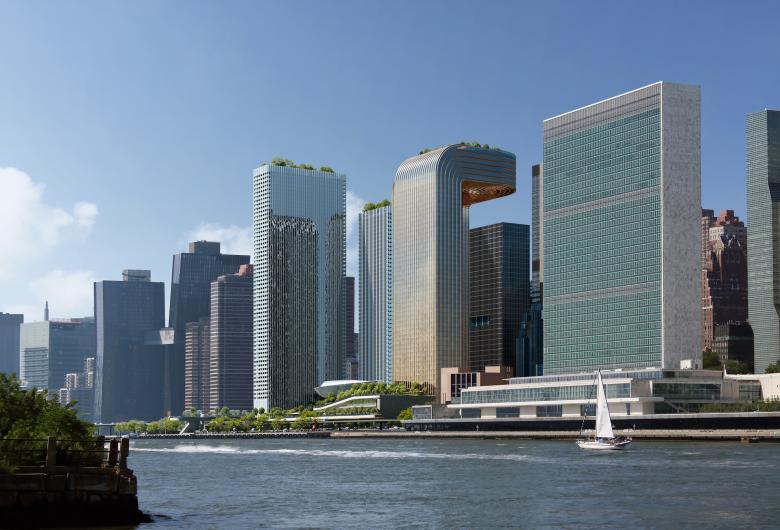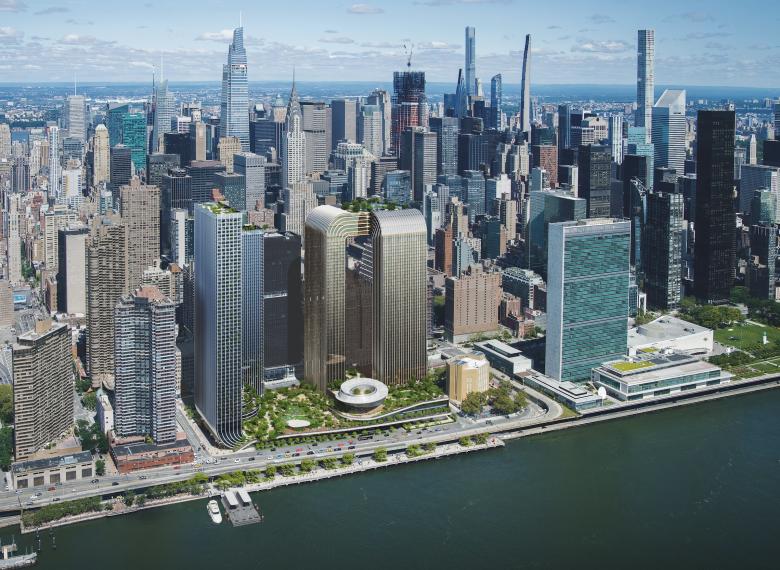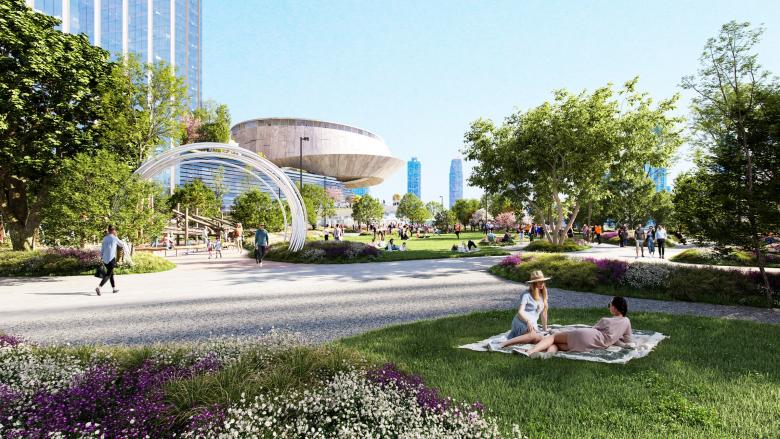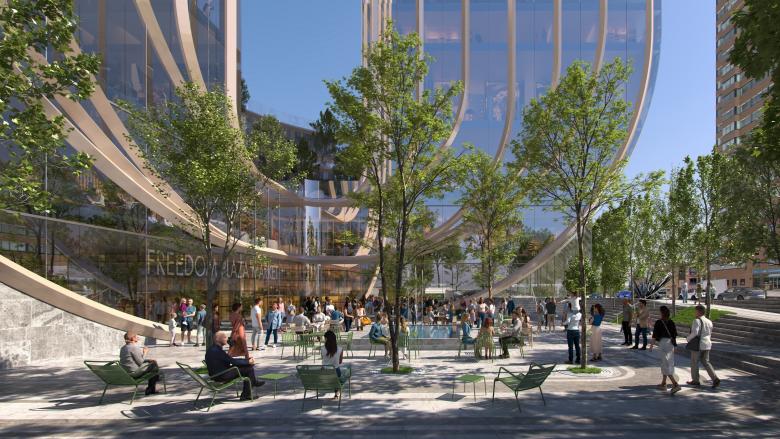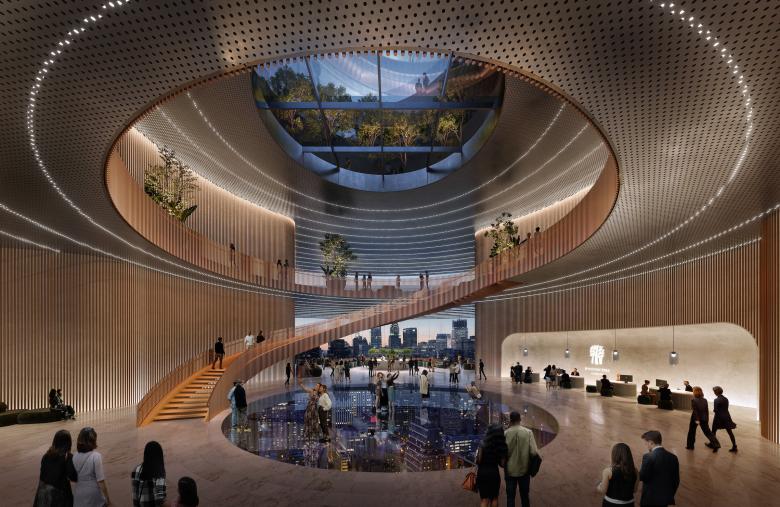Freedom Plaza proposal by BIG–Bjarke Ingels Group
A BIG Attempt to Land a Casino in Manhattan
John Hill
15. February 2024
Visualization © Negativ
BIG–Bjarke Ingels Group and developers Soloviev Group and Mohegan have unveiled Freedom Plaza, a proposed mixed-use development on three blocks south of the United Nations that could be the site of New York City's first casino.
Some people in New York City are calling 2024 the year of the casino. Two years ago, state politicians authorized the awarding of three casino licenses for downstate New York. (Although voters approved Vegas-style gambling in 2013, then-governor Andrew Cuomo allowed upstate casinos to move forward first, so they didn't have to compete directly with NYC.) Lobbyists and people closely tracking the process assume two of the three licenses will go to the two already functioning “racinos” — facilities that have race tracks and slot machines but no card games, table games, and other Vegas-style gambling — in the area, one in Ozone Park, Queens, and the other in Yonkers, just north of the Bronx, since they can more easily and quickly expand to include casinos. That means local developers and national and international casino operators have to vie for just one license, and, as Freedom Plaza indicates, they are piling on neighborhood amenities to entice the powers-that-be to grant it to them.
Visualization © Negativ
As of last fall, per a New York Times report, eight developers/casino operators are vying for the assumed single license. Five of them are located in Manhattan and all five of those are in Midtown, somewhere between 30th Street and 50th Street:
- Hudson Yards (Related Companies with Wynn Resorts), Manhattan
- Times Square (SL Green Realty with Caesars Entertainment), Manhattan
- Saks Fifth Avenue (Hudson’s Bay Company), Manhattan
- Freedom Plaza (Soloviev Group with Mohegan), Manhattan
- Midtown West (Larry Silverstein with Watche Manoukian), Manhattan
- Coney Island (Thor Equities Group with Saratoga Casino Holdings and the Chickasaw Nation), Brooklyn
- Willets Point (Steven Cohen with Hard Rock International), Queens
- Bally's Golf Links at Ferry Point (Bally's Corporation), The Bronx
Of the five Midtown Manhattan proposals, two of them would put the casino in existing buildings (Times Square and Saks), while the other three would include the casino as part of larger developments: at the base of two mixed-use towers with Silverstein; in the second phase of Hudson Yards, which was originally slated to be residential; and on a long-unbuilt empty void immediately south of the UN along the East River.
Visualization © Negativ
The three-block, 6.7-acre empty space that is now named Freedom Plaza, and which is already home to the Field of Light art installation, is owned by the Soloviev Group, the company run by Stefan Soloviev, son of developer Sheldon Solow, who died in 2020. (Soloviev uses an older spelling of the family name.) The Soloviev Group is the successor company to the Solow Building Corporation, which bought numerous parcels, including these the three blocks, from Consolidated Edison in 2000; the power company was decommissioning its power plant on the site, a process that took more than half a decade, so the plant was gone and the three blocks were graded by 2007. Put another way, the three-block site south of the UN has sat empty, fenced-off for fourteen years — no wonder it is being eyed for the lucrative casino bid.
Visualization © BIG
Casinos are seen by proponents as tax generators that help fund schools and other public institutions, but opponents see them as places that generate traffic, entice already impoverished people to spend what little money they have, and encourage gambling addicts. Either way, a casino just steps from the United Nations, an organization that explicitly exists to “find shared solutions that benefit all of humanity,” is highly questionable; quizzical at best. Seeming to anticipate the expected naysayers, the Freedom Plaza team is proposing a long list of buildings and programs unrelated to the casino, which goes by the less loaded term “gaming facility” in a press release and would be practically invisible, buried beneath a 4.77-acre public park designed by OJB Landscape Architecture.
Visualization © Bucharest
The other pieces of the development, all designed by BIG–Bjarke Ingels Group and comprising the bulk of the development, are:
- Two residential towers, 50 and 60 stories, that would include 1,325 apartments, nearly 40% of them permanently affordable;
- Two 51-story hotel towers (a Banyan Tree hotel and a Mohegan hotel)
- A conference and entertainment center; and
- The Museum of Freedom and Democracy.
Visualization © Bucharest
The proposed Museum of Freedom and Democracy is the most overt attempt to align the development with its famous neighbor. Bjarke Ingels says in a statement that it “celebrates the origin and evolution of one of the most impactful inventions of mankind and our continuous struggle to build, maintain and protect the institutions that uphold it.” Anchoring the park, the museum takes the shape of a Möbius strip, providing walking paths atop it and sitting above a similarly shaped amphitheater “as a symbol of unity.” The form of the amphitheater “takes cues from the traditional Greek theater as a nod to those who created democracy thousands of years ago.”
Visualization © Negativ
Similar to the way the museum's geometry is based on an infinite loop, the two pairs of towers are linked with curved elements: the two residential towers at the base and the two hotel towers at the top. The latter link creates the proposal's most distinctive skyline element and provides space for a sizable rooftop amenity space with panoramic views. Curiously, the hotel's rooftop “bridge” brings to mind the nearby American Copper Buildings (visible at left in the top rendering), which were designed by SHoP Architects after JDS Development bought the land from Sheldon Solow when he was unable to move forward with plans for a larger development on the ConEd site in the aughts. SHoP designed the two ACB towers with a skybridge at their midpoints, and now BIG is putting its own spin on skybridges, linking the tops of two towers with a curved one. Bridging, it turns out, is a popular theme along the East River in Midtown Manhattan — architecturally and metaphorically, as the Freedom Plaza team tries to connect with the local community and its international neighbor. If the team can build that bridge remains to be seen: most like at least a year, as reports indicate a mid-2025 announcement on the three casino bids for downstate New York.
Visualization © Bucharest
Related articles
-
A BIG Attempt to Land a Casino in Manhattan
2 months ago
-
Foster Redesigning 2 WTC
on 9/14/21
-
The Smile
on 12/17/20
-
BIG's 'Spiral' Gets the Green Light
on 4/10/18
-
BIG's VIA 57 West Wins Skyscraper Award
on 12/5/17
